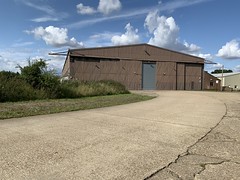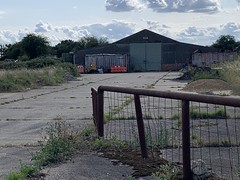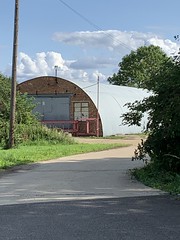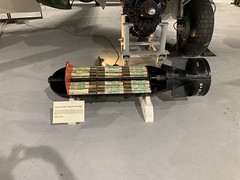In Part 1, we saw how Little Staughton had developed initialled used by the USAAF as a depot for repairs and refurbishments, and how soon after it was handed back to the RAF and the Bennett’s Pathfinders.
The end of 1944 would be pivotal though, but not the happy celebratory time it should have been, but a solemn and heart rendering time for those stationed here.
On December 23rd 1944, twenty-seven Lancasters along with their three Mosquito reserves, would take off from Little Staughton and their sister airfields at Bourn and Gravely, to be joined by their escorts – three squadrons of Mustangs from 150 Wing, over France. Once out of the English fog and cloud that had harassed the bombers for several days before hand, the aircraft began to jostle for their correct position in the formation. The three formations, each made up of two Flights, A and B, would gradually settle down now able to see each other in the clearer skies above the heavy English cloud.In such a clear sky, it might be ill-considered to think that anything could go drastically wrong – but go wrong it did.
 The watch office at Little Staughton is now a listed building.
The watch office at Little Staughton is now a listed building.Assemblies could always be a danger and would be unsettling for any crew. At the back of the six flight formation and unseen to the Little Staughton crews at the front, Graveley’s 35 Sqn’s Flying Officer G.S. Lawson in Lancaster ‘H-How’ (PB683) began closing in on his friend Pilot Officer R. Clarke in ‘F-Freddie’ (PB678). Misjudging the narrow distance between them, Lawson’s aircraft inadvertently made contact with the wing of Clarke’s, sending both aircraft, fully laden with fuel and bombs, spiralling to the icy waters of the English Channel below. As the two Lancasters fell uncontrollably towards Earth, others in the formation could do nothing except watch in horror and prey that chutes would somehow emerge from the two Lancasters. Miraculously, six airmen did manage to escape the stricken bombers before they either broke apart due to the extreme forces exerted upon them, or they hit the water.
A rescue search was mounted immediately. Little Staughton’s reserve pathfinder Mosquito from 105 Sqn, who was sat at the rear of the formation and witnessed everything, remained on station continually radioing the airmen’s positions back to control. He remained there, watching out, until the launch arrived to begin the arduous task of searching for signs of life. But the icy winter waters of the channel were too much for the badly protected airmen, and although six managed to escape the stricken bombers, all the crew of the launch could do was pull dead bodies from the cold water. Only one crewman was unaccounted for, the body of Flt.Lt. John Faulkner was some weeks later washed up on the beach at Dieppe. He remains buried there to this day.
Meanwhile, the front two formations consisting of Lancasters from Little Staughton flew on oblivious to the carnage that had occurred behind them. Being an Oboe operation meant that the aircraft had to fly for fifteen minutes straight and level without any deviation from the beam they were following. Hopefully, the predicted cloud over the target would give them some protection from flak and fighters, hence the reason for using Oboe. When they got there however, there was none, just clear bright skies and it was daylight. Ramrod 1415 was about to feel the brunt of the Luftwaffe’s determined pilots.
The first formation had somehow become detached from the second and third, meaning their escort was way behind and having to race to catch-up. With eight minutes to target they were alone, in clear skies and vulnerable.
It was then that the flak began. 88mm and 105mm shells began exploding all around the aircraft, peppering the fuselages like hailstones on a tin can.
Within minutes the gunners had found their mark, and the first aircraft was hit. Mosquito ML998 ‘HS-B’ with 25 year old Flt. Lt. Eric Carpenter, a Canadian, and Fl. Off. William Lambert as navigator, was on fire with both engines out. Moments later, the Mosquito exploded in a massive fireball. Neither airmen would survive and Little Staughton was now one crew down.
With three minutes to go, not only had the flak intensified but fighters had appeared on the scene too. The master bomber, Sqn. Ldr. Robert Palmer in Lancaster PB 371 ‘V’, received hits causing two engines to cut. His Lancaster was now more than ever difficult to fly but on he went fighting the reluctant aircraft every inch of the way. Then further hits badly damaged the Lancaster’s tail forcing the aircraft to turn over and tumble out of the bright German sky.
As the aircraft tumbled over and over, the rear gunner Flt.Sgt. R Yeulatt, another Canadian, manged to escape his turret, more by luck than skill. After his turret was separated from the spiralling Lancaster his body was forced out between the doors by the wind. This incredible escape would be his saviour – he would be the only survivor of the seven man crew.
With all Lancasters receiving intense fire it was going to be carnage – and it was.
 One of the original hangars still in use today.
One of the original hangars still in use today.The second Lancaster to fall from the sky was that of American (RCAF) Flt.Lt. Arndt Reif in PB120 ‘P’. Reid’s aircraft was hit by both flak and enemy fighters. Reif himself was badly injured, and so he gave the order to bale out. Only two crewmen, Flt. Sgts MacLennan and Pearce, both Canadians, escaped with their lives, being picked up on the ground and incarcerated by the Germans.
Flt. Lt. R. Hockley in Lancaster PB141 ’60-F’ went down next. With no controls and one wing on fire, he gave the order to jump, and all seven crewmen managed to escape the burning wreck. Six were picked up by the Germans below, the seventh, 24 year old Pilot Officer Ken Hewitt was attacked by murderous civilians and shot several times. Efforts to save him by a local policeman failed and the murder was the subject to a post war criminal investigation, which concluded that the fatal shot came from Hubert Wester, who was later killed on the Eastern front. No other charges were brought against any of those present.
With one Mosquito and three Lancasters now gone, the deaths were stacking up. Fl. Off. R. Terpenning, an Australian, in Lancaster PB558 ‘A’ had by now taken several hits and was flying ‘on the deck’ to try and make his escape. Pounced on by further fighters, time was definitely of the essence.
The Lancaster’s gunners fought bravely to ward off continued determined Luftwaffe attacks. Fuel now streamed from the wing; two engines were out; the top turret had been severely damaged and many controls were out of action, it was a miracle the aircraft was still in the air. Once over Belgium and the relative safety of the allied lines, Terpenning gave the order to bale out, himself being the last to leave. All seven airmen made it safely out of the Lancaster and were back at Little Staughton just four days later.
By now chaos reigned. Communications were bad at best. Only some aircraft received the order to scatter and had done so, others meanwhile received orders to bomb visually and not by Oboe. Some of the formation dispersed, each aircraft beginning its own unscheduled bomb run.
The last of the formation aircraft to come down was that piloted by 22 year old Flt. Lt. Peter Thomas, in Lancaster PB523 ‘J’. It, like the others, had received substantial hits and was doomed to crash. After battling against persistent fighters and damaged controls, Thomas finally gave the order to bale out. With himself and a wounded Canadian P. Off. Frederick (Tex) Campbell upfront, the remaining crew escaped and the aircraft crashed. In the wreckage still at the controls, was the body of the pilot Flt. Lt. Thomas.
Of those who escaped four became prisoners of war, the fifth, twenty year old Flt. Sgt. Vivian Hobbs was killed after his chute collapsed on the descent.
Of the seventeen Little Staughton 582 Sqn Lancasters that went to Cologne that day, five failed to return along with a Mosquito of 109 Sqn. With a further two Lancasters from Gravely a total of eight aircraft were lost that day, along with all but one of their crews. The operation had been a disaster from the start, and the crews had paid the price.
After the operation Sqn. Ldr. Palmer, who was on his third operational tour and 111th sortie, was posthumously awarded the Victoria Cross for his determination in continuing on to the target, even though his aircraft was severely damaged. He insisted on flying straight and level to allow Oboe to pinpoint the target. As a result the crew placed their markers precisely on the target allowing those left following to bomb accurately.*3
The full story and VC citation for Sqn Ldr. Palmer, can be read in ‘Heroic Tales‘.
 A Robins Aircraft Hangar still in use today.
A Robins Aircraft Hangar still in use today.The return trip to Cologne on New Year’s eve must have filled the crews with dread, however it proved to be uneventful in that all aircraft returned safely and without incident. Although losses were comparatively light for the two units, seventeen aircraft lost from 109 Sqn and around thirty from 582; equating to some 250 airmen in total; it was still a blow to the squadrons and to Little Staughton as a whole.
With a successful and uneventful last operation, the dawn of 1945 must have brought renewed hope for fewer losses and that of a forthcoming allied victory.
The poor weather of the Christmas period however, did little to deter operations over Germany. On 1st January 1945, 582 Sqn were once again in action flying to both Dortmund and Witten. For almost fifteen days crews would be flying operations, training flights or both. It was a gruelling time but losses were low. It wasn’t until the 16th-17th that the first aircraft would go down. Baling out over allied territory all crew apart from the rear gunner, Sgt. McNamara, survived. With 109 Sqn losing only one Mosquito on the 31st – again both airmen returning safely – January had proven light despite the increase in operations.
It was then in February that another Little Staughton airman would earn himself the Victoria Cross, the second for bravery and dedication to duty.
On the night of 23rd-24th February, only ten days after the historical attack on Dresden that resulted in a firestorm, 367 Lancasters and 13 Mosquitoes from 1, 6 and 8 Groups were detailed to attack the city of Pforzheim to the north-west of Stuttgart. This would be the only attack on the city and it would prove almost as devastating as Dresden and Hamburg.
The Master Bomber that night was a 582 Squadron Lancaster piloted by the only South African pilot in the Pathfinders, Captain Edwin Swales DFC. In his Lancaster III PB538 ‘N’, were seven other crewmen, including two navigators.
On the run in to the target, the Lancaster was badly hit by night fighters putting one engine and the rear turret guns out of action. Undeterred, Swales continued to perform his role, guiding the following bombers onto the target with the greatest of precision.
Only when he was satisfied that the attack had been carried out did he leave the target area. Now easy prey to more attacks, soon a second engine was put out of action, controls were damaged with some being inoperable. With a reduced speed and difficult flying conditions he headed for the allied lines, and once safely over them, he gave the order to bale out. All those on board made the jump to safety, leaving Swales at the control trying to maintain steady flight. Just as the last man left, the Lancaster gave up the struggle and was reported to hit high tension cables causing it to crash. Captain Swales was still at the controls when it was found later on.
The attack on Pforzheim was considered to be very accurate, with over 1,800 bombs having been dropped in little over twenty minutes. Over 17,000 people were known to have died that night in the raging fire that followed, and a post-war photograph, revealed that 83% of the built up area had been destroyed by the raid*4.
Swales’ VC was awarded posthumously, being the second such award to go to airman of Little Staughton, and the third of only three to the Pathfinders. His citation appeared in the Fifth Supplement to The London Gazette, of Friday, the 20th of April, 1945, and concluded: “Intrepid in the attack, courageous in the face of danger, he did his duty to the last, giving his life that his comrades might live.” His story also appears in ‘Heroic Tales’
The war was by now drawing to its inevitable conclusion, and the end of the Nazi’s reign of terror was near. For Little Staughton crews however, the job was far from over. By now the allies were so close to Germany that Oboe stations and forward operating airfields allowed accurate Oboe bombing of Berlin. On the 8th March 109 Squadron’s history was made with their first Oboe marking of Berlin and Munich; the longest range they ever attempted. Eighteen aircraft were ordered out to four targets, the other two being Dessau and Hamburg, The night was not the most successful though, with technical problems causing issues with a number of Pathfinder aircraft. On the Hamburg raid, four of the six aircraft marked well, one aircraft lost an engine and had to return early, whilst over Berlin, two of the four markers had to return without marking also due to technical issues. The Dessau raid suffered similar technical issues.
By now the war was in its last stages, and the night of 20th-21st April saw yet another pivotal moment in the history of the war, with the RAF’s last attack on the German capital. 109 Sqn were again in action, and it was Mosquito XVI ML929, piloted by F.O. A.C. Austin and F.O. P. Moorhead, who claimed the honour of dropping the last RAF bomb on the city. It was yet another feather in the cap for Little Staughton crews.
 One of the original hardstands now has farmers sheds on it.
One of the original hardstands now has farmers sheds on it.Other German cities then took the brunt of the Allied attacks. To the south, allied troops were approaching Hitler’s lair at Berchtesgaden, but the night’s attack in April would not be one to remember, as all Little Staughton’s aircraft suffered technical issues preventing them from marking the target. It is thought that the surrounding mountains had interrupted the Oboe signal leading to poor reception by the Pathfinders. Due to fog and snow, identifying the target was then made more difficult for the following bombers, but with relatively accurate strikes, the raid was considered a success. However, it was not to be the Pathfinder’s final night of glory.
Attention then turned to Manna operations, and 109 began to mark targets in Holland for food parcels. A remarkable effort allowing foodstuffs and urgent supplies to be dropped to starving civilians in Holland.
Whilst bomber command was concentrating on humanitarian flights, 109 Squadron took part in the final raid on Kiel on May 2nd-3rd, with four aircraft taking part. One suffered problems and was unable to mark leaving the remaining three to identify and mark the target. It was solely a Mosquito attack using aircraft from both 8 and 100 Group, after which large fires were seen rising from several parts of the town. After the last remnants of the German army left, it was declared ‘undefended’ and open, and allied troops entered unopposed just 36 hours later.
With the war’s end, the Pathfinders returned to dropping markers for food supplies, and ‘cooks’ tours began, aircrew taking ground crews on ‘sight-seeing’ trips over Germany to show the extent of the devastation caused by the war and the allied pounding of Germany’s towns and cities. An event that really brought home the effects of the war on Germany.
In September 1945 after much speculation and many staff movements, both squadrons were ordered to disband. 582 was first on the 10th with 109 Squadron soon after on the 30th. A glimmer of hope then came for 109 Sqn, when it was reborn through the renumbering of 627 Sqn at Woodhall Spa. To all intents and purposes though it was a different squadron to the one that had worked so hard and with such dedication here at Little Staughton. The operational record books for 582 Squadron simply states: “No further entry, Squadron disbanded as of 10th September 1945“. On roll were 147 airmen and 92 Officers, six of which were New Zealanders. The records also show that the squadron had dropped over 8,000 tons of bombs cumulatively, while 109 Sqn recorded: “This is the finish, all our aircraft were flown to Upwood today.”
Some 522 raids had been flown by 109 Squadron, covering over a staggering 5,400 sorties, while at either Little Staughton, Wyton or Marham, all with a loss of just 18 aircraft. 582 on the other hand had flown over 2,100 sorties in 165 raids with a loss of 28 Lancasters all whilst based at this little airfield in the Cambridgeshire countryside*4.
Throughout the war, thoughts had never been far away from post war aviation and in particular the development of new, larger and faster aircraft, both military and civil. With it would come the demand for bigger airfields and longer runways, which led to a search for possible extensions to existing airfields. Farnborough and the RAE (Royal Aircraft Establishment), was the preferred choice, but the site was penned in and unable to have its runway extended to the five miles thought necessary to accommodate new types of aircraft. Alternatives were sought with the final decision being the amalgamation of three airfields: Twinwood Farm, Thurleigh and Little Staughton; a five mile runway linking Thurleigh with Little Staughton which would then be linked by a taxi way with Twinwood Farm. The idea behind the huge development was to replicate the Californian Muroc test facility (now Edwards Air Force Base) to enable testing of new developments in aviation. The idea never materialised though, and would have no doubt faced serious opposition had it ever got to the consultation phase*1.
So, with no real need for Little Staughton it was soon surplus to military requirements, and with their dramatic reduction of assets, its days were sadly numbered.
Following the departure of the two squadrons, the airfield became used as a transport base, before finally closing in December 1945, and being placed into care and maintenance. In the 1950s the runway was given consideration again and work began to extend it for use in emergencies by US military aircraft, but this was also a short lived exercise, and by the end of the decade this too had ceased, and the site was closed to all military activity. For a short while it was used by the civilian Brooklands Aviation company as a repair depot, but was soon returned to farmland although the runway, and some of the perimeter tracks remain, used by a small aviation company along with several of the hangars which are used by light industry.
The Watch Office continues to stand and is now a Grade II listed building, being listed in December 2005 for its ‘special architectural and historic interest’. Historic England describe it as “One of a very small number of control towers of the Second World War period that have survived in a substantially complete state of preservation…This is an exceptionally well-preserved example of a 1941 control tower design for bomber satellite stations, of which 24 out of 45 built survive.”*2
With that, Little Staughton quietly slipped in to the history books. The buildings left standing echoing the hectic activities of two Pathfinder Squadrons, from which over 250 airmen lost their lives.
582 Sqn had been purposefully created for a role, a role it performed to the highest standard and with the greatest pride of any squadron in the RAF. 109 Sqn had performed with the same dedication and determination, meaning that Little Staughton crews were awarded two of the three VCs the Pathfinders earned, the highest honour to be bestowed on any military personnel. In addition to these, numerous other gallantry medals were also awarded to the many crews of both squadrons, a number of whom had flown in excess of 100 sorties whilst based here at Little Staughton.
 Remnants of the airfield still exist as farm tracks.
Remnants of the airfield still exist as farm tracks.Little Staughton was only operational for a short period of time. But in that time it achieved some of the highest accolades possible in military terms. It brought a great sense of pride to the local area, and a huge influx of men and machinery. Today it stands quiet, just outside of the village which marks its history with a small stone laid close to the end of the main runway. The local church, All Saints, also has a roll of honour commemorating all those personnel who lost their lives here, and a memorial stone close by pays homage to those who served and died in this remarkable place.
The entire story can be read in Trail 29.
*3 Much of the report from this comes from a combination of Operational record books and secondary resources including Feast., S., “Heroic Endeavour“, Grub Street Publications, 2006.
*4 Middlebrook, M., Everitt. C., “The Bomber Command War Diaries“, Midland Publishing Ltd, 1996
National Archives Operational Records:
AIR 27/2052/2; AIR 27/2052/1; AIR 27/854/8; AIR 27/854/7; AIR 27/2052/7; AIR 27/2052/8; AIR 27/2052/10; AIR 27/2052/9; AIR 27/855/2; AIR 27/2052/14; AIR 27/2052/13; AIR 27/856/7; AIR 27/856/9; AIR 27/2449/1; AIR 27/2052/27


